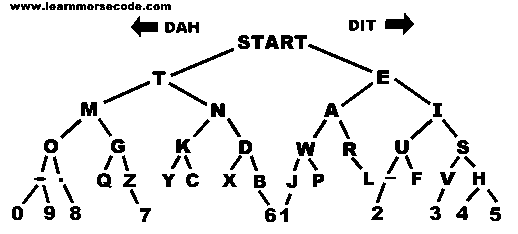Project:Morse Code Training: Difference between revisions
(notes added.) |
|||
| Line 11: | Line 11: | ||
It is one of the easiest ways to use a minute amount of bandwidth to send and receive information over long distances. Consider it to be one of the best 'bang-for-the-buck' communication protocols in existence. The UK Foundation licence has a practicals requirement that requires people to be able to send and receive a few basic sentences in Morse. (No memorisation required - code is sent/received quite slowly too) | It is one of the easiest ways to use a minute amount of bandwidth to send and receive information over long distances. Consider it to be one of the best 'bang-for-the-buck' communication protocols in existence. The UK Foundation licence has a practicals requirement that requires people to be able to send and receive a few basic sentences in Morse. (No memorisation required - code is sent/received quite slowly too) | ||
== | == London Hackspace Morse Experts == | ||
[[User:MattP|MattP]] | |||
== Cheat Sheet == | == Cheat Sheet == | ||
| Line 32: | Line 29: | ||
*Wikipedia on [https://en.wikipedia.org/wiki/Morse_code Morse code], especially section Learning methods | *Wikipedia on [https://en.wikipedia.org/wiki/Morse_code Morse code], especially section Learning methods | ||
*[http://www.learnmorsecode.com/ Learn Morse code] Learn Morse code in one minute | *[http://www.learnmorsecode.com/ Learn Morse code] Learn Morse code in one minute | ||
*[http://coins.hallwindmeter.com/ Morse Code Coins] are a nice pocket reference for encoding/decoding Morse code | |||
[[Category:Amateur Radio]] | [[Category:Amateur Radio]] | ||
Latest revision as of 12:24, 17 March 2015
What is Morse
Morse code is a binary method of transmitting text information as a series of on-off tones, lights, or clicks that can be directly understood by a trained listener or observer without special equipment.
Basic Morse Code encodes the 26 letter latin alphabet, some extra Latin letters, the Arabic numerals and a small set of punctuation and procedural signals as standardized sequences of short and long signals called "dots" and "dashes" or "dits" and "dahs". Because many non-English natural languages use more than the 26 Roman letters, extensions to the Morse alphabet exist for those languages.
(Summary adapted from the Morse wikipedia entry)
Understanding Morse: Why Bother?
It is one of the easiest ways to use a minute amount of bandwidth to send and receive information over long distances. Consider it to be one of the best 'bang-for-the-buck' communication protocols in existence. The UK Foundation licence has a practicals requirement that requires people to be able to send and receive a few basic sentences in Morse. (No memorisation required - code is sent/received quite slowly too)
London Hackspace Morse Experts
Cheat Sheet
While listening to morse code. Move down and to the right every time you hear a DIT (a dot). Move down and to the left every time you hear a DAH (a dash). The key to learning the code is hearing it and comprehending it while you hear it. The only way to get there is to practice 10 minutes a day.
Listen to code while tracing out this chart and you will find yourself writing down the letters in no time at all without the aid of the chart. The chart brings repetition together with recognition, which you don't get from any other type of code practice aid.
External links
- Just Learn Morse Code PC program
- Wikipedia on Morse code, especially section Learning methods
- Learn Morse code Learn Morse code in one minute
- Morse Code Coins are a nice pocket reference for encoding/decoding Morse code
